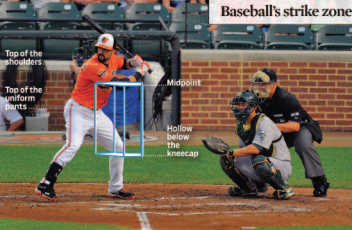
College baseball has made the decision to emphasize the "high strike" this spring. A major contributing factor to this attempted change dates back to the "gorilla ball" era of -5 bats, big barrels, and a 1998 national championship-deciding game that ended in a 21-14 win for Southern California over Arizona State. Pitchers far and wide began to stray from the heart of the plate, picking more and more at the corners and the bottom of the zone. Over time, umpires began to expand their own zones as a result.
More than 15 years after the 1998 College World Series final that read much more like a Pac 12 football contest, aluminum bat restrictions have been handed down and box scores look much different. Unfortunately, so does the strike zone. Believe it or not, the "high strike" has become an endangered species across amateur baseball.
As the game has continued to ask pitchers to keep the ball down and at the corners, umpires have acquiesced by widening the zone for pitchers that "earn it." This has resulted in a conundrum for college baseball, as different umpires have developed slightly different strike zones through the years. Admittedly, it's hard enough for umpires to call the low strike, which is the hardest one for them to see. While the age-old adage "it's where it crosses the plate" ought to hold true, many borderline pitches are decided on the catcher's framing ability. Thus, if a catcher is able to receive a low pitch with subtle movements, it is often called a strike, even if it may be underneath or alongside the actual strike zone.
Where utilizing the high strike call becomes confusing is how it is defined, as it depends largely on the height of the batter. Considering that some lineups consist of hitters that range several inches in height (one example is TCU, which regularly starts 5-8 Boomer White and 6-5 Kevin Cron), the duty of calling the high strike consistently becomes a challenge for all umpires. Taller batters are given an advantage here because even though their strike zone is perceived to be larger, a letter-high pitch seems much more like a strike if it's caught just under the letters of a 5-8 hitter. When a catcher reaches up to receive a pitch at the same relative height (just under the letters) of a 6-5 hitter, it just looks more like a ball. Simply put, the farther away the catcher reaches from where he sets up, the harder it is for umpires to call it a strike.
It's too early to tell whether emphasis on the high strike will truly affect the game or not, however there will definitely be a learning curve for umpires. They've called their own strike zones for their whole careers, and now they're asked to change? While many umps are likely to make an attempt to comply with the new guidelines, some don't see much change on the horizon. "I'm not going to change a thing," said one NCAA Division I umpire, "I've always tried to be consistent and call the plate on every hitter. For me to try to change could compromise the integrity of the game."
It will be interesting to see if more pitchers play with throwing the ball up in the zone for called strikes. It's a dangerous place to be nibbling at the plate, but it's a new avenue that can be opened up to make things harder for the hitter. There are those that chase pitches away or in the dirt and there are guys that you can get in on, but if you can make hitters worry a little more about getting rung up on a fastball around the letters, it can create more of a defensive mindset for offenses.
NCAA Director/West Coast Conference Coordinator of Umpires Tom Hiler presented new guidelines for the strike zone at this year's ABCA Convention and NCAA Umpire Clinics. Subsequently, NCAA National Coordinator of Baseball Umpires Gene McArtor posed a simple question everyone will be asking (online at
https://ncaabaseball.arbitersports.com/): "Can we commit to making every effort to improve strike zone consistency by calling the strike zone as defined, including the high strike and low strike and eliminate the tendency t